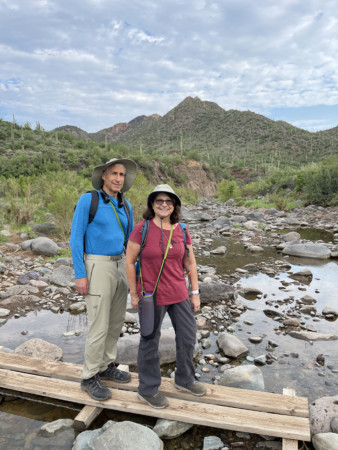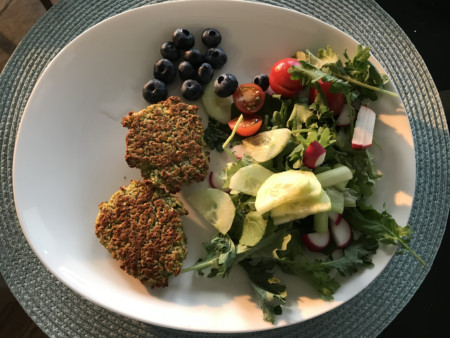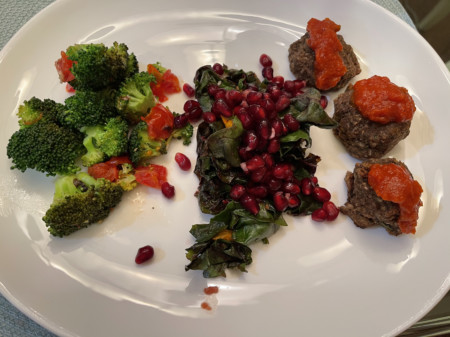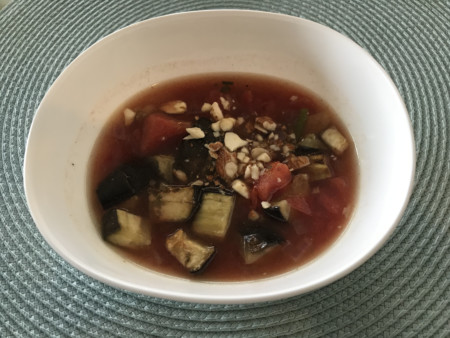Over a year ago, I reached out to Dr. William W. Li to review Eat to Beat Disease: The New Science of How the Body Can Heal Itself. I wanted to explore the connection between diet and health.
Within days of Ira’s diagnosis of glioblastoma, an incurable brain cancer, I received my complimentary copy. Suddenly, I was focusing on how to fight cancer cells. Would it be possible to use the information presented in Eat to Beat Disease to create menus that would help Ira survive glioblastoma? In other words, could our food choices affect Ira’s ability to recover from a craniotomy, six weeks of chemo and radiation, a second round of chemo lasting six months, and become an outlier?

Earlier this month, we celebrated the one year anniversary of Ira’s diagnosis. Within a week of diagnosis, Ira had a craniotomy to remove the glioblastoma tumor. After recovering from his surgery, the standard of care treatments began.
Our multi-tiered, redefined lifestyle choices produced positive results. Ira was receptive. These changes are advocated for longevity and to beat cancer.
When restructuring our diet, I incorporated some of Dr. Li’s ideas along with information obtained from cancer cookbooks as well as books on a variety of subjects—longevity, keto diets for cancer, intermittent fasting, plant-based diets, maintaining positivity, and how to survive terminal cancer.
Angiogenesis
In Eat to Beat Disease, I learned about the body’s five defense systems—angiogenesis, regeneration, microbiome, DNA protection, and immunity. The potential healing power of eating a wide variety of nutrient-dense foods became my focus. I also read about the connection between angiogenesis and cancer.
Every single type of solid tumor, ranging from breast to prostrate to lung to colon, must have angiogenesis to grow beyond a pinpoint size. Without angiogenesis, cancer cells cannot spread. (Page 100)
After completing Chapter 6, I made an effort to use most of the 72 foods that Dr. Li singled out for their antiangiogenic properties, on page 127, in my menu planning.
Since we were already consuming many of these healthier foods, it was easy to incorporate a few more items. My cancer cookbook recipes included these ingredients. Whenever possible, I rotated these ingredients on a weekly basis so that we had diversity in our menus. Contrary to some who advocate the magical powers of a small number of foods, I recognize the benefit of eating a variety of plant-based foods with a small amount of animal protein, predominately from fish. If I needed to label our food intake, it would fall into the category of a Mediterranean or Asian diet.
Regeneration
When discussing ways to regenerate one’s health, Eat to Beat Disease readers are reminded of the ill effects of too much sugar.
… high levels of sugar incapacitate our regenerative defense system. Food and beverages that raise blood sugar block the production of stem cells, lowering your body’s ability to repair organs…Elevated blood sugars have been shown to cripple and kill important stem cells across the board, from endothelial progenitor cells to bone progenitor cells to cardiac stem cells. If you need your stem cells to be at their best, take a low glycemic index approach to your diet. This means minimizing or avoiding altogether sugary, processed foods containing little or no fiber that can cause blood sugar to spike, such as sugar sweetened beverages and many packaged snack foods. (page 149)
It is impossible to ignore this warning about excess sugar. If I could do one thing that potentially would lessen the likelihood of the cancer cells grouping together, I was willing to try it. By using cancer cookbooks and anti-inflammatory cookbooks, I created healthy meals and snacks with minimal amounts of sugar. Instead of adding white sugar to recipes, I used minimal amounts of maple syrup, agave, monk sugar, and pulverized fruit. Additionally, I started using a variety of nut and plant-based flours as a substitute for everyday white flour. By making almost everything from scratch, I not only was able reduce our daily sugar consumption but I was also able to minimize our consumption of processed foods.
Dr. Li also discusses ketogenic diets and glioblastoma stem cells. While the preliminary evidence cited indicates that high sugar consumption promotes the growth of glioblastoma stem cells, it remains unclear whether the long-term use of a ketogenic diet is beneficial and practical for glioblastoma patients.
After doing additional research, Ira rejected this extreme diet in favor of a low sugar diet. Our dietary changes lowered Ira’s A1C to between 4.8 and 5.0. I was simultaneously able to reap the benefits of our new menus. My latest blood tests show that I am no longer pre-diabetic. Chapter 7 concludes with a chart outlining key foods that affect regeneration. (Page 156)

Microbiome
Having read other books that reveal the connection between the microbiome, the immune system, and the brain, I was eager to read Dr. Li’s suggestions.
The guiding principles for taking care of your gut microbiome follow three basic rules of thumb: Eat lots of dietary fiber from whole foods. Eat less animal protein. Eat more fresh, whole foods and less processed food.” (Page 170) Once again, Dr. Li provided a useful list of probiotic and prebiotic foods at the end of the Feed Your Inner Ecosystem chapter. (Page 188).
Our Mediterranean/Asian style diet follows these practices.
DNA Protection
Decades ago, I read about the role that anti-oxidants play in reducing free radicals. If left unchecked, oxidative stress occurs and a person’s DNA can be damaged. While some people turn to over-the-counter supplements to address this issue, I was interested in seeing which foods can rectify the situation. While foods can be useful if the level of free radicals are not at a high level, the overall effect is diminished when the body is coping with an overload of toxins or inflammation.
Foods can trigger health defenses that are naturally wired into our DNA. Some foods can speed up the repair of broken DNA, after the damage has taken place. What we eat can also switch certain genes on or off through so-called epigenetic changes. In addition to diet, exercise, sleep, and environmental exposure can also have good (and bad) epigenetic effects. But foods that have a positive epigenetic influence can unleash beneficial genes or turn off harmful ones to prevent and fight disease. (Page 191)
As I gain a better understanding of this process, I am hoping that the foods we are eating will continue to protect us from other cancers caused by DNA errors. Not surprisingly, many of the key foods affecting DNA (Page 217) also appear on other charts.

Immunity
Knowing that Ira’s immune system would be compromised by surgery, chemo, and radiation, I read the chapter on how to activate your immune command center multiple times. I wanted to include foods that stimulated Ira’s immune system while simultaneously combating my higher than normal stress levels.
After being exposed to COVID during our frequent trips to the UC Health Anschutz Cancer Pavilion, we both needed to improve our immune systems. Once again, there was a bit of overlap with the recommended foods found on page 247. To help isolate the foods which appear on multiple charts, an all-star list of grand slammer appears on page 303, along with a list of seafood high with levels of healthy fat on page 306.
5X5X5 Framework
Instead of advocating a specific diet plan, Dr. Li offers flexibility by introducing a 5 X 5 X 5 framework. On pages 260-263, more than 200 foods are listed. Dr. Li recommends that individuals select five foods to target each of the five health defense systems. By following this protocol, people will be enjoying at least 35 nutrient dense foods weekly. While the last five in the framework refers to breakfast, lunch, dinner, snack and dessert, Dr. Li advocates flexibility. People are free to select their own meal schedule. Appendix A recaps the recommended foods for each defense category. (pages 371-378) For encouragement, he also includes meal guides, recipes, and kitchen strategies.
After researching the reaction of foods and pharmaceutical drugs on angiogenesis in a laboratory setting, Dr. Li has observed the potency of certain edible ingredients. On pages 349-351, one can scan through a list of foods along with suggested doses for particular diseases. However, Dr. Li warns against the idea that particular foods are magic bullets. He cites five reasons (pages 352-353) why this information may not be accurate for all individuals.
Tweaking Menus for Balance
Having spent the last year addressing Ira’s glioblastoma dietary needs, I agree with Dr. Li that balance is essential.
In biology there is an important concept that everyone should know about called hormesis. In simple terms, hormesis describes the response of a complex system, where a small amount of a stimulus (like food) is beneficial, and a bit more is a bit better. But, there is a peak amount of stimuli where more doesn’t result in further benefit. In fact, a lot more can lead to loss of the benefit and even harmful effect. (Page 354)
To conform to this important principle, I prepare diverse menus while avoiding excessive amounts of any particular ingredients. However, my emphasis has been on Dr. Li’s antiangiogenic and immunity food lists.
Diet and Glioblastoma
When faced with the reality of an incurable disease, Ira and I both realized that we could not rely fully on the standard of care traditional treatments. Since we did not want to pursue clinical trials or unproven off-label drug cocktails, we knew that our lifestyle choices would become paramount to our success. Food was just one aspect to our daily approach to defeat glioblastoma.
Eat to Beat Disease, along with countless other resources, opened the door to the importance of daily food choices. Instead of just five healthy foods, I adopted a more in-depth and comprehensive plant-based routine. Whenever possible, our plates are filled with nutrient-dense foods—fruits, vegetables, whole grains, legumes, fungi, seeds and nuts. Portions of fish and meat are kept to a minimum and I infrequently included dairy products. Meals have become increasingly more flavorful as my comfort level with spices and herbs has improved. Olive oil, avocados, coconut oil, sesame oil and ghee replaced less healthier options. Without the convenience of processed foods, I spend a tremendous amount of time on my feet preparing foods in my kitchen. Fortunately, we live in an area with farm to table restaurants. A couple of times a month, we will indulge in a cheat meal.

I am thankful for the advice I found in a handful of cancer cookbooks. The recipes introduced me to blended drinks (also known as smoothies), nutrient-dense soups, sauces and dressings, and a host of ingredients that I had previously never purchased. I still rotate many of these recipes into my weekly plans. These suggestions minimized the ill effects of Ira’s toxic treatments.
As we head into uncharted territory, post standard of care treatments, I will continue to rely on Dr. Li’s food lists when I plan and prepare diverse menus with an enormous amount of plant-based ingredients.
Related Posts
Should Glioblastoma Patients Investigate Radical Remission?
Anyone who is looking for ways to beat the odds, should read this.
Mark Your Calendar -Glioblastoma Awareness Day – July 21, 2021
To bring attention to Glioblastoma, Sandy highlighted the ability to embrace life after a glio diagnosis.
Celebrating Wedding Anniversary in Kauai, Hawaii
To celebrate their 46th wedding anniversary and life, Sandy and Ira explored Kauai.
Spring Getaway to Captiva Island, Florida
A late spring getaway took us to romantic and picturesque Captiva Island.
Grand Hyatt Vail Healthy Cuisine
Yes, you can maintain a healthy diet while traveling.
Tackling the Back Bowls at Vail While Media Guests at the Grand Hyatt Vail
Can you believe that until spring 2021, I had never skied at Vail? Thanks to a media trip hosted by the Grand Hyatt Vail, Ira and I explored this amazing terrain and our youngest son, Jordan, led the way to their famous back bowls.
While Ira was undergoing chemo, we went horseback ride, snowshoe, and learned archery at Vista Verde Ranch, a luxury dude ranch near Steamboat, Colorado.
New Year’s Tradition at Keystone Resort
Glioblastoma and chemo did not stop Ira from skiing more than 20 times with glioblastoma.
BIO
Sandra Bornstein is the author of May This Be the Best Year of Your Life. Sandra’s memoir highlights her living and teaching adventure in Bangalore, India. She was a licensed Colorado teacher who taught K-12 students in the United States and abroad. Sandra also taught college-level courses at Front Range Community College and the University of Colorado-Boulder.
In addition to reviewing books and interviewing authors, Sandra is an award-winning author and lifestyle and travel journalist. Many of Sandra’s travel stories appear on the For Readers Page. To follow Sandra’s travel adventures, visit TheTravelingBornsteins website.

Connect with Sandra